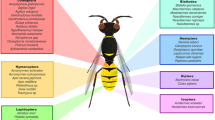Abstract
Commensal bacteria influence many aspects of an organism’s behaviour. However, studies on the influence of commensal bacteria in insect mate-selection are scarce. Here, we present empirical evidence that commensal bacteria mediate mate-selection in the Oriental fruit fly, Bactrocera dorsalis. Male flies were attracted to female flies, but this attraction was abolished when female flies were fed with antibiotics, suggesting the role of the fly’s microbiota in mediating mate-selection. We show that male flies were attracted to and ejaculated more sperm into females harbouring the microbiota. Using culturing and 16S rDNA sequencing, we isolated and identified different commensal bacteria, with Klebsiella oxytoca being the most abundant bacterial species. This preliminary study will enhance our understanding of the influence of commensal bacteria on mate-selection behaviour of B. dorsalis and may find use in devising control operations against this devastating pest.


Similar content being viewed by others
References
Fraune S, Bosch TC (2010) Why bacteria matter in animal development and evolution. Bioessays 32:571–580. doi:10.1002/bies.200900192
Gilbert SF, Sapp J, Tauber AI (2012) A symbiotic view of life: we have never been individuals. Q Rev Biol 87:325–341. doi:10.1086/668166
Ezenwa VO, Gerardo NM, Inouye DW, Medina M, Xavier JB (2012) Microbiology: animal behavior and the microbiome. Science 338:198–199. doi:10.1126/science.1227412
McFall-Ngai M, Hadfield MG, Bosch TC, Carey HV, Domazet-Lose T, Douglas AE et al (2013) Animals in a bacterial world, a new imperative for the life sciences. Proc Natl Acad Sci U S A 110:3229–3236. doi:10.1073/pnas.1218525110
Theis KR, Venkataraman A, Dycus JA, Koonter KD, Schmitt-Matzen EN, Wagner AP et al (2013) Symbiotic bacteria appear to mediate hyena social odors. Proc Natl Acad Sci U S A 110:19832–19837. doi:10.1073/pnas.1306477110
Hoyt CP, Osborne GO, Mulcock AP (1971) Production of an insect sex pheromone by symbiotic bacteria. Nature 230:472–473. doi:10.1038/230472a0
Dillon RJ, Vennard CT, Charnley AK (2000) Exploitation of gut bacteria in the locust. Nature 403:851. doi:10.1038/35002669
Andersson M, Simmons LW (2006) Sexual selection and mate choice. Trends Ecol Evol 21:296–302. doi:10.1016/j.tree.2006.03.015
Benelli G, Daane KM, Canale A, Niu CY, Messing RH, Vargas RI (2014) Sexual communication and related behaviours in Tephritidae: current knowledge and potential applications for integrated pest management. J Pest Sci 87:385–405. doi:10.1007/s10340-014-0577-3
Shelly TE (2001) Feeding on methyl eugenol and Fagraea berteriana flowers increases long-range female attraction by males of the oriental fruit fly (Diptera: Tephritidae). Fla Entomol 84:634–640. doi:10.2307/3496395
Shelly TE, Kaneshiro KY (1991) Lek behaviour of the oriental fruit fly, Dacus dorsalis, in Hawaii (Diptera: Tephritidae). J Insect Behav 4:245–241. doi:10.1007/BF01054615
Baker R, Bacon AJ (1985) The identification of spiroacetals in the volatile secretions of two species of fruit fly (Dacus dorsalis, Dacus cucurbitae). Experientia 41:1484–1485. doi:10.1007/BF01950049
Nation LJ (1981) Sex-specific glands in tephritid fruit flies of the genera Anastrepha, Ceratitis, Dacus and Rhagoletis (Diptera : Tephritidae). Int J Insect Morphol Embryol 10:121–129. doi:10.1016/S0020-7322(81)80017-7
Andongma AA, Wan L, Dong YC, Li P, Desneux N, White JA, Niu CY (2015) Pyrosequencing reveals a shift in symbiotic bacteria populations across life stages of Bactrocera dorsalis. Sci Rep 5:9470. doi:10.1038/srep09470
Twig E, Yuval B (2005) Function of multiple sperm storage organs in female Mediterranean fruit fly (Ceratitis capitata, Diptera: Tephritidae). J Insect Physiol 51:67–74. doi:10.1016/j.jinsphys.2004.11.007
Bayers JA, Wood DL (1981) Antibiotic-induced inhibition of pheromone synthesis in a bark beetle. Science 213:763–764. doi:10.1126/science.213.4509.763
Shi Z, Wang L, Zhang H (2012) Low diversity bacterial community and trapping activity of metabolites from cultivable bacteria species in the female reproductive system of the oriental fruit fly, Bactrocera dorsalis Hendel (Diptera: Tephritidae). Int J Mol Sci 13:6266–6278. doi:10.3390/ijms13056266
Ami EB, Yuval B, Jurkevitch E (2009) Manipulation of the microbiota of mass-reared Mediterranean fruit flies Ceratitis capitata (Diptera: Tephritidae) improves sterile male sexual performance. ISME J 4:28–37. doi:10.1038/ismej.2009.82
Sharon G, Segal D, Ringo JM, Hefetz A, Wilber-Rosenberg I, Rosenberg E (2010) Commensal bacteria play a role in mating preference of Drosophila melanogaster. Proc Natl Acad Sci U S A 107:20051–20056. doi:10.1073/pnas.1009906107
Yuval B, Ben-Ami E, Behar A, Ben-Yosef M, Jurkevitch E (2013) The Mediterranean fruit fly and its bacteria—potential for improving sterile insect technique operations. J Appl Entomol 137:39–42. doi:10.1111/j.1439-0418.2010.01555.x
Acknowledgments
We thank Mr. Sagar J and Miss Lakshmi HS for their help in conducting olfactometer bioassays. We thank Dr. Toby Bruce of Rothamsted for proofreading the manuscript. This work was supported by grants from the Indian Council for Agricultural Research’s [ICAR] granted to KJPD and VK through the National Fellow Project and AA through NICRA Project. A part of this study is the doctoral work of AA. The authors also thank the Applied Zoologists Research Association for conferring the authors with the “Edita David Memorial Award” for this work.
Author contribution
VK and AA designed the study, VK and AA conducted bioassays and other experiments, VK wrote the first draft of the manuscript and KJPD contributed to the final version of the manuscript. KJPD, AA and VK contributed equally to the manuscript.
Author information
Authors and Affiliations
Corresponding author
Electronic supplementary material
Below is the link to the electronic supplementary material.
Fig. S1
Schematic representation of Bacterial choice assay. Individual bacteria grown (stationary phase) in Luria broth (Treatment) and Luria broth alone (control) were pipetted (20 μL) onto filter paper discs. These discs were placed into plastic containers with an entry hole of 20 mm diameter on top and presented to virgin males or female flies (15 days old, 30 flies) in separate netted cages (30 × 30 × 30 cm) for a period of 15 min. The number of flies that were inside the treatment container (responders) and control or on the cage walls (non-responders) was counted. Three replicates for each bacterial isolate were conducted. (GIF 14 kb)
High resolution image
(TIFF 3755 kb)
Table S1
Bacterial communities in virgin female B. dorsalis and attraction of symbiotic bacteria to virgin male and female flies. (XLSX 55 kb)
Rights and permissions
About this article
Cite this article
Damodaram, K.J.P., Ayyasamy, A. & Kempraj, V. Commensal Bacteria Aid Mate-selection in the Fruit Fly, Bactrocera dorsalis . Microb Ecol 72, 725–729 (2016). https://doi.org/10.1007/s00248-016-0819-4
Received:
Accepted:
Published:
Issue Date:
DOI: https://doi.org/10.1007/s00248-016-0819-4




